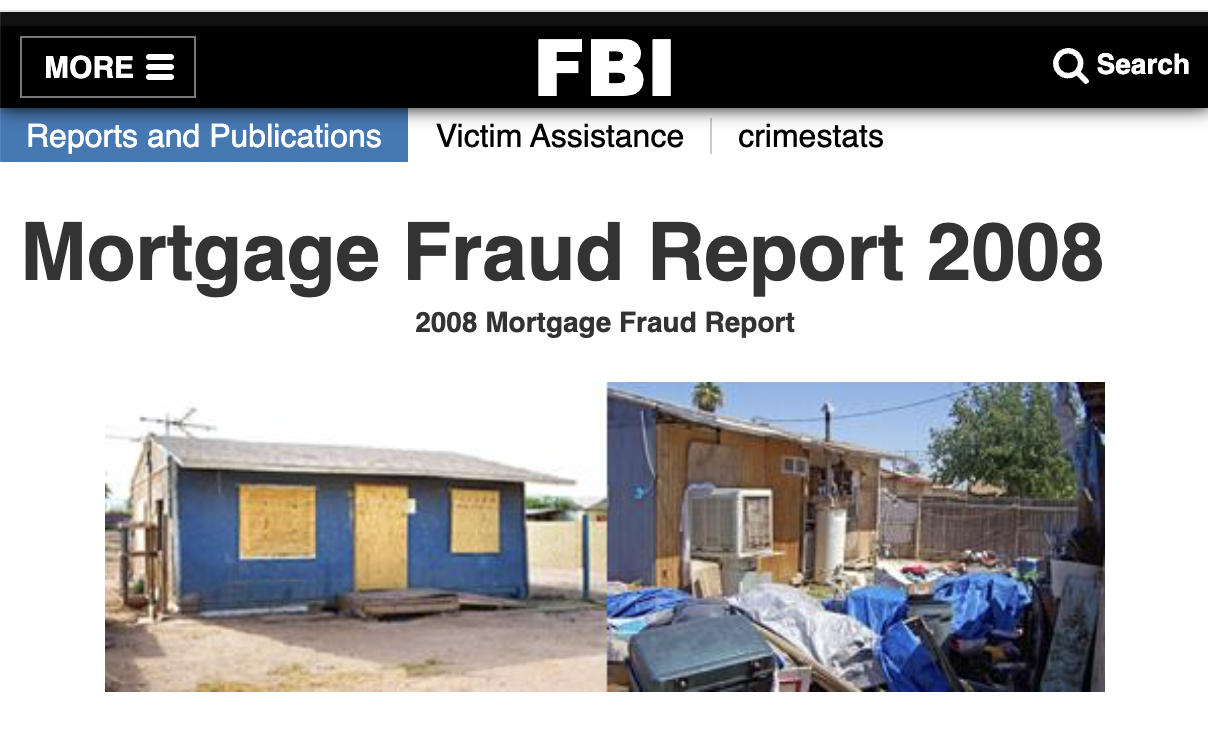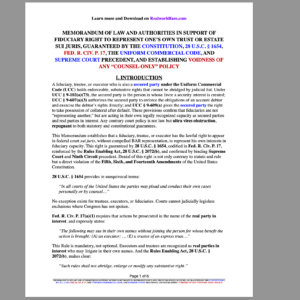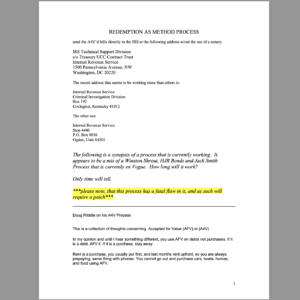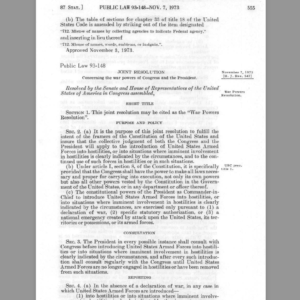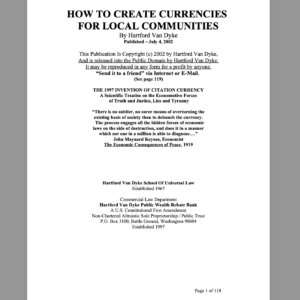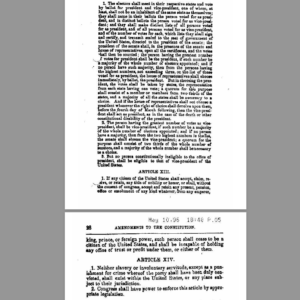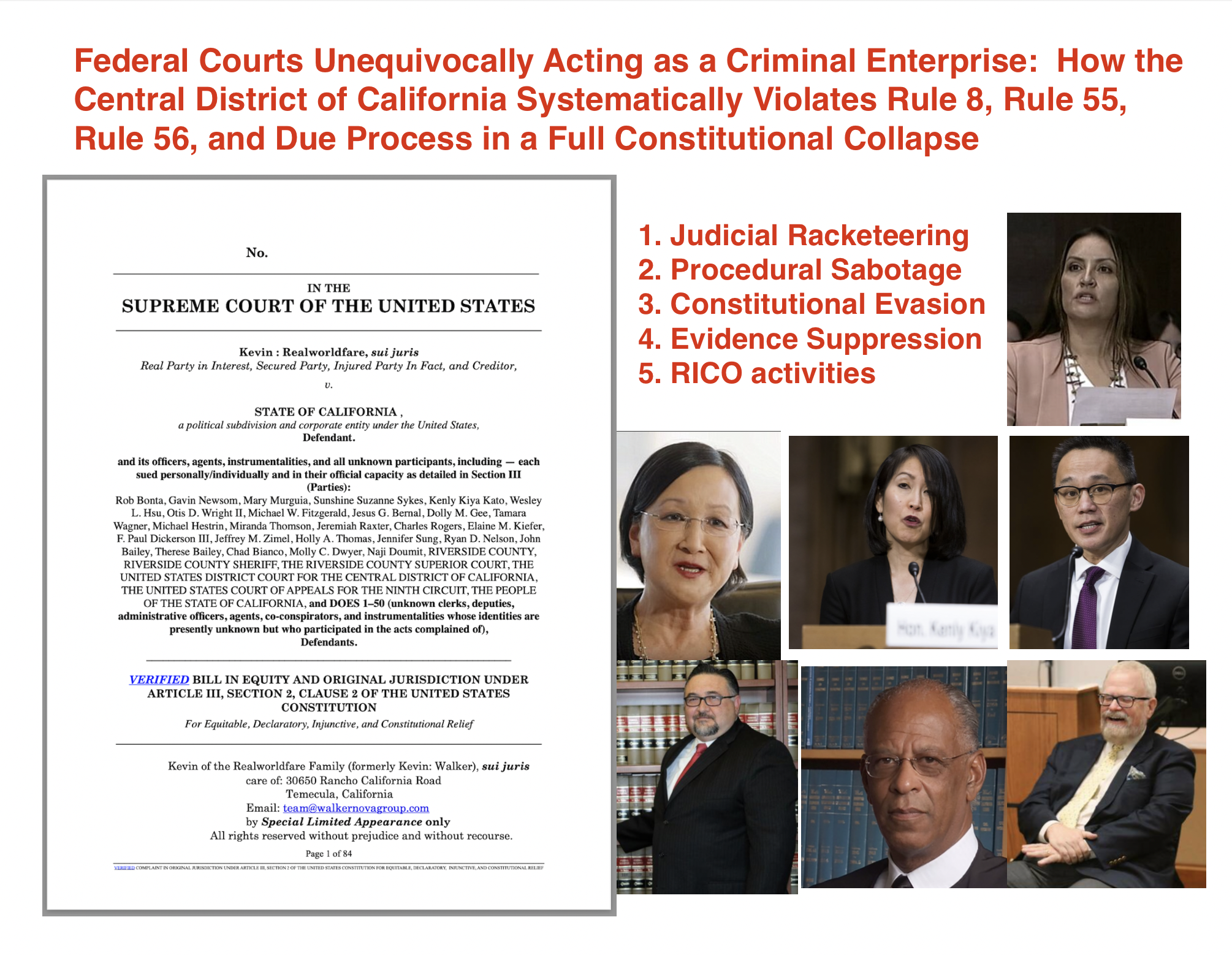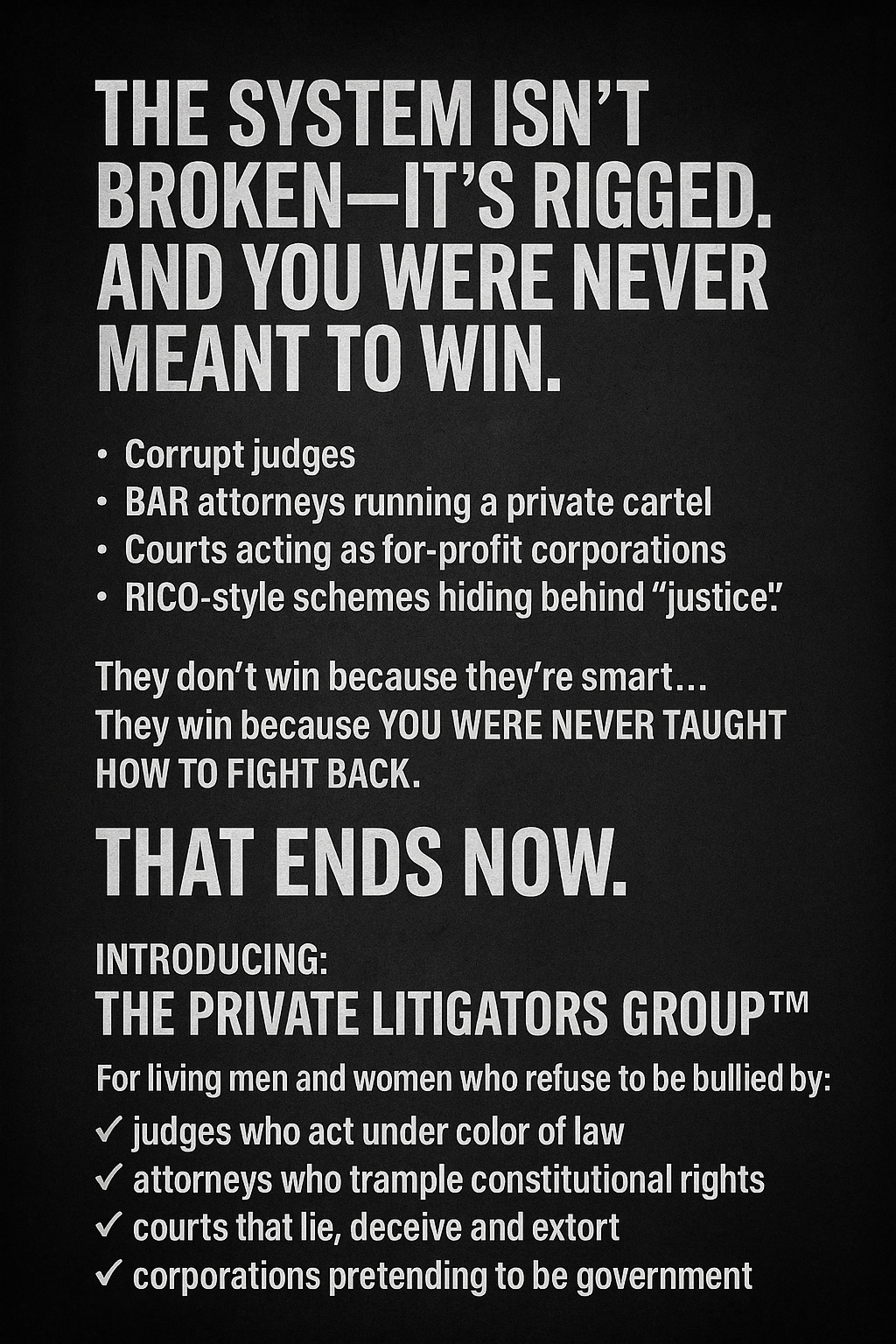Scope Note
The purpose of this study is to provide insight into the breadth and depth of mortgage fraud crimes perpetrated against the United States and its citizens during 2008. This report updates the 2007 Mortgage Fraud Report and addresses current mortgage fraud projections, issues, and the identification of mortgage fraud “hot spots.” The objective of this study is to provide FBI program managers with relevant data to better understand the threat, the trends, allocation of resources, and to prioritize investigations. The report was requested by the Financial Crimes Section, Criminal Investigative Division (CID), and prepared by the Financial Crimes Intelligence Unit (FCIU), Directorate of Intelligence (DI).
This report is based on FBI, state, and local law enforcement, mortgage industry, and open-source reporting. Information also was provided by other government agencies, including the US Department of Housing and Urban Development-Office of Inspector General (HUD-OIG), Federal Housing Administration (FHA), Internal Revenue Service, US Postal Inspection Service, and the Federal National Mortgage Association. Suspicious Activity Reports (SARs) were obtained from the Financial Crimes Enforcement Network (FinCEN). Industry reporting was obtained from the Mortgage Asset Research Institute (MARI), RealtyTrac, Inc., Mortgage Bankers Association (MBA), Interthinx, and Radian Guaranty, Inc. Some industry reporting was acquired via open-sources.
While the FBI has high confidence in all of these sources, some inconsistencies relative to how various organizations catalog their statistics are noted. SARs are cataloged according to the year in which they are submitted. However, their information may describe activity that occurred months or years previously. The geographic specificity of industry reporting varies; some companies report at the zip code level, others by city, region, or state. Many of the statistics provided by the external sources, including FinCEN, FHA, and HUD-OIG are captured by fiscal year, while this report focuses on the calendar year findings. While these discrepancies have minimal impact on the overall findings stated in this report, we have noted specific instances in the text where they may affect conclusions.
See Appendix B for additional information for these sources.
Geospatial maps were provided by the Geospatial Intelligence Unit, DI and the Crime Analysis Research and Development Unit, Criminal Justice Information Services Division.
Key Findings
- Mortgage fraud continued to be an escalating problem in the United States during 2008. Although no central repository exists for collecting mortgage fraud complaints, virtually all law enforcement and industry statistics indicated an upswing in mortgage fraud activity. SAR mortgage fraud filings from financial institutions increased 36 percent to 63,713 during Fiscal Year (FY) 2008 compared to 46,717 filings in FY2007. The total dollar loss attriSbuted to mortgage fraud is unknown; however, at least 63 percent (1,035) of all pending FBI mortgage fraud investigations during FY2008 involved dollar losses totaling more than $1 million.
- A decrease in loan originations and an increase in defaults and foreclosures continued to dominate the downward trend in the housing market in 2008. While the amount of mortgage fraud cannot be precisely determined, industry experts agree that there is a direct correlation between fraud and distressed real estate markets. As the housing market continued to decline in response to an increase in housing inventories, lack of sales, and new foreclosures surface, to include a wave of Alt-A and Option ARM loans due to reset beginning in April 2009, real estate values softened, and fraud reporting increased throughout 2008.
- Analysis of available law enforcement and industry information indicates the top states for mortgage fraud during 2008 were California, Florida, Georgia, Illinois, Michigan, Arizona, Texas, Maryland, Missouri, New Jersey, New York, Ohio, Colorado, Nevada, Minnesota, Rhode Island, Massachusetts, Pennsylvania, Virginia, and the District of Columbia. Rhode Island , Massachusetts , Pennsylvania , and the District of Columbia were new to the list in 2008, replacing Utah , Indiana , Tennessee and Connecticut from 2007.
- The downward trend in the housing market during 2008 provided a favorable climate for mortgage fraud schemes to proliferate. Several of these schemes have the potential to spread if the current economic downward trend, as expected, continues into 2009 and beyond. Increases in foreclosures, declining housing prices, and decreased demand place pressure on lenders, builders, and home sellers. These and other market participants are perpetuating and modifying old schemes, including property flipping, builder-bailouts, short sales, and foreclosure rescues. Additionally, they are facilitating new schemes, including reverse mortgage fraud, credit enhancements, condo conversion, loan modifications, and pump and pay in response to tighter lending practices.
Introduction
Mortgage fraud trends in 2008 reflected the overall downturn in the US economy initiated by the sub-prime mortgage crisis of 2007. The US stock markets suffered their deepest losses since the 1930s; unemployment increased dramatically; the mortgage loan industry reported a spike in foreclosures and defaults; and financial markets continued to contract, diminishing credit to financial institutions, businesses, and homeowners. These combined factors uncovered and fueled a rampant mortgage fraud climate fraught with opportunistic participants desperate to maintain or increase their current standard of living. Industry employees sought to maintain the high standard of living they enjoyed during the boom years of the real estate market and overextended mortgage holders were often desperate to reduce or eliminate their bloated mortgage payments.
| Mortgage Fraud Defined
Mortgage fraud is a material misstatement, misrepresentation, or omissions relied upon by an underwriter or lender to fund, purchase, or insure a loan. Mortgage loan fraud is divided into two categories: fraud for property and fraud for profit. Fraud for property/housing entails misrepresentations by the applicant for the purpose of purchasing a property for a primary residence. This scheme usually involves a single loan. Although applicants may embellish income and conceal debt, their intent is to repay the loan. Fraud for profit, however, often involves multiple loans and elaborate schemes perpetrated to gain illicit proceeds from property sales. Gross misrepresentations concerning appraisals and loan documents are common in fraud for profit schemes and participants are frequently paid for their participation. Although there is no centralized reporting mechanism for mortgage fraud complaints or investigations, numerous regulatory, industry, and law enforcement agencies collaborate to share information used to assess the current fraud climate. Source: FBI Financial Crimes Section, Finanical Institution Fraud Unit, Mortgage Fraud : A Guide for Investigators, 2003. |
Mortgage fraud continues to be an escalating problem in the United States and a contributing factor to the billions of dollars in losses in the mortgage industry. Recent congressional economic stimulus legislation and the proliferation of FHA-insured mortgages are providing funding streams for perpetrators to further exploit this industry. Multiple fraud schemes are being conducted by industry professionals who are in a position to exploit the current depressed housing market. Market conditions are also fueling the use of traditional and emerging schemes which have the potential to multiply across jurisdictions as foreclosures increase, the market contracts, access to credit diminishes, and more homeowners are unable to sell or refinance their homes. Properties affected by these schemes negatively impact neighborhoods; federally insured loan programs; the mortgage, banking, and securities industries; secondary market investors; tax payers; homeowners; and the overall US economy.
Mortgage fraud provides perpetrators, including mortgage brokers, lenders, appraisers, underwriters, accountants, real estate agents, settlement attorneys, land developers, investors, builders, bank account representatives, trust account representatives, investment banks, and credit rating agencies with a criminal activity which is relatively low-risk with high-yield returns. Rising housing prices and exotic financial instruments, including teaser-rate adjustable rate mortgages, low or zero-equity loans, and sub-prime loans allow them to shift the risk to others.1 Despite increased scrutiny, many industry insiders will perpetrate fraud to maintain or increase their current standard of living. In addition to traditional industry conspirators, there have been instances involving various organized criminal groups and gang members involved in mortgage fraud activity.
Victims of mortgage fraud activity may include borrowers, mortgage industry entities, and those living in neighborhoods affected by mortgage fraud. As properties affected by mortgage fraud are sold at artificially inflated prices, properties in surrounding neighborhoods also become artificially inflated. When this happens, property taxes also artificially increase. As unqualified homeowners begin to default on their inflated mortgages, properties go into foreclosure and neighborhoods begin to deteriorate, and surrounding properties and neighborhoods witness their values depreciating. As this happens, legitimate homeowners find it difficult to sell their homes. Additionally, the decline in US home values has a direct correlation to state and local government’s ability to provide resources for schools, public safety, and other necessary public services which are funded in large part from property tax revenue.2
The schemes most directly associated with the escalating mortgage fraud problem continue to be those defined as fraud for profit. Fraud for profit schemes often employ the use of a variety of loan products in addition to a standard conventional loan, such as sub-prime loans, Alt-A loans, Home Equity Lines of Credit (HELOCs), option-adjustable rate mortgage (ARM) loans, and Home Equity Conversion Mortgage loans. Prominent schemes include builder bail-out, short sale, foreclosure rescue, credit enhancement, loan modification, illegal property flipping, seller assistance, bust-out, debt elimination, mortgage backed securities, real estate investment, multiple loan, assignment fee, air loan, asset rental, backwards application, reverse mortgage fraud, and equity skimming. Many of these schemes employ various techniques such as the use of straw buyers, identity theft, silent seconds, quit claims, land trusts, shell companies, fraudulent loan documents (to include forged applications, settlement statements, and verification of employment, rental, occupancy, income, and deposit), double sold loans to secondary investors, leasebacks, and inflated appraisals.
Financial Institution Reporting of Mortgage Fraud Increases
Suspicious Activity Reports (SARs) from financial institutions indicate an increase in mortgage fraud reporting. There were 63,713 mortgage fraud related SARs filed with FinCEN in FY2008, a 36-percent increase from FY2007. Preliminary statistics indicate SAR filings in FY2009 will exceed 70,000 (see Figure 1).3
SARs reported in FY2008 revealed losses of more than $1.4 billion, an increase of 83.4 percent from FY2007 (see Figure 2). Additionally, SAR losses reported in the first six months of FY2009 exceed the same period in FY2008 by $208 million.
Mortgage Fraud in a Depressed Housing Market
| New Targets for Fraud: Money from Economic Stimulus Programs
Various programs implemented by Congress as a result of the Emergency Economic Stabilization Act (EESA) and the Housing and Economic Recovery Act (HERA) have the potential to provide new targets for mortgage fraud activity as perpetrators vie for billions of dollars provided by these programs. Vulnerabilities associated with these and similar programs, include the lack of transparency, accountability, oversight, and enforcement that predisposes them to fraud and abuse. These vulnerabilities could potentially lead to or contribute to an increase in government fraud, mortgage fraud, corporate fraud, and public corruption. Sources: Government Accountability Office; GAO-09-161; available at www.gao.gov/new.items/d09161.pdf; “Troubled Asset Relief Program: Additional Acitons Needed to Better Ensure Integrity, Accountability, and Transparency;” December 2008. |
Decreased loan originations and an increase in buy-backs and foreclosures dominated the downward housing trend in the housing market in 2008. While the amount of mortgage fraud cannot be precisely determined, industry experts agree there is a direct correlation between fraud and distressed real estate markets. As the housing market continues to decline in response to an increase in housing inventories, lack of sales, and new foreclosures surface, real estate values will continue to soften and fraud will continue to increase.
The housing market is expected to continue this downward trend at least in the near-term until results of the efforts initiated by the authority of the Housing and Economic Recovery Act of 2008 and other market factors begin to stabilize the economy. Residential property values fell from $21.5 trillion in 2007 to $19.1 trillion in 2008, a $2.4 trillion or 11.1-percent decrease.4 US home prices were at their lowest levels since May 2004 due to accelerated depreciation in 75 percent of all metropolitan markets, and housing inventory remained very high (see Figure 3 for states with the most significant decline in home prices and Figure 4 for markets with highest depreciation in home prices).5 Rapid contraction in the economy in addition to deteriorating labor markets, the large inventory of unsold homes, and increasing foreclosures and defaults suggest that home prices will continue to decline through 2009.6 According to the Mortgage Bankers Association, as of March 2009, 5.4 million American homeowners holding a mortgage, nearly 12 percent, were at least one month behind in their payment or in foreclosure at the end of 2008.
|
|
||||||||||||||||||||||||||||||||||||||||||||||||||
A recent trend resulting from the collapse of the sub-prime mortgage market has been the migration of originators and borrowers back to FHA-backed mortgages. FHA’s market share has increased from 3 percent in 2006 to more than 30 percent in 2009, making it an attractive market for exploitation by former sub-prime lenders.7 Further, the number of FHA approved lenders increased more than 350 percent from FY 2006 to FY 2008 (see Figure 5).8
The MBA estimates that mortgage loan originations will continue to decline through 2009 while defaults continue to increase (see Figure 6).9 The MBA National Delinquency Survey (NDS) examines 85 percent of the outstanding first-lien mortgages in the market. The NDS reported 45.4 million first-lien mortgages on 1 to 4 unit residential properties in 2008, a 592,000 decrease from 2007. Conversely, the NDS reported a fourth quarter increase in foreclosure rates for the same period.10
In addition to the significant impact from the effects of lax due diligence in sub-prime lending, Alt-As (designed for prime-quality borrowers often requiring no documentation) and Option ARMs (designed for slightly better than sub-prime borrowers) are beginning to reset and will continue to reset over the next three years.11 Borrowers who were teased into these products with initially low interest rates, sometimes as low as 1 percent, are witnessing a significant increase in their monthly mortgage payment and are consequently defaulting on these mortgages.12
As the demand for mortgage originations have declined, so too has the sub-prime share of the mortgage market. As of the third quarter 2008, the sub-prime share of outstanding loans had decreased slightly since 2007. By contrast the FHA share of outstanding loans had increased since 2007 (see Figure 7).13
The number of FHA endorsements has also increased more than 193 percent since FY2006 (see Figure 8).14 Additionally, FHA reported a 239-percent increase in the total dollar amount of annual mortgage loans it insured, growing from $75.6 billion in 2007 to $256.3 billion in 2008.15
Top Geographical Areas for Mortgage Fraud
Methodology
Data from law enforcement and industry sources were compared and mapped to determine which areas of the country were most affected by mortgage fraud during 2008. This was accomplished by compiling the state rankings by each data source, collating by state and then mapping the information. The call-out boxes within the map (see Figure 9) depict the originating source with its ranking.
| Figure 9: Top Mortgage Fraud States (multiple indicators ranked states 1 to 10 for each source), 2008 |
Information from the FBI, HUD-OIG, FinCEN, MARI, Fannie Mae, RealtyTrac, Inc., MBA, Interthinx, and Radian Guaranty, Inc., indicate that the top mortgage fraud states for 2008 were California, Florida, Georgia, Illinois, Michigan, Arizona, Texas, Maryland, Missouri, New Jersey, New York, Ohio, Colorado, Nevada, Minnesota, Rhode Island, the District of Columbia, Massachusetts, Pennsylvania, and Virginia (see Figure 9).
The states of California and Florida were identified by all eight of the aforementioned data sources as having a mortgage fraud problem. Georgia and Illinois were identified by seven (7) data sources, Michigan (6), Arizona and Texas (5), Maryland , Missouri, New Jersey, New York, and Ohio (4), Colorado and Nevada (3), Minnesota and Rhode Island (2), and the District of Columbia, Massachusetts, Pennsylvania, and Virginia (1). Five contributing data sources rank California first in their top 10 lists as having the most significant mortgage fraud problem. Rhode Island , Massachusetts , Pennsylvania , and the District of Columbia were new in 2008, replacing Utah , Indiana , Tennessee and Connecticut from 2007.
Breakdown of Sources Used to Identify Top Mortgage Fraud Areas
Federal Bureau of Investigation
FBI mortgage fraud investigations totaled 1,644 in FY2008, a 37-percent increase from FY2007 and a 100-percent increase from FY2006 (see Figure 10). Sixty-three percent (1,035) of all pending FBI mortgage fraud investigations as of FY2008 involved dollar losses of more than $1 million.
Regional analysis of FBI pending mortgage fraud-related investigations as of FY2008 revealed that the west region of the United States led the nation with the most pending investigations. The west region was followed by the north central, southeast, northeast, and south central regions, respectively (see Figure 11).
FBI field divisions that ranked in the top 10 for pending investigations during FY2008 include Los Angeles, Detroit, Chicago, New York, Miami, Dallas, Atlanta, Denver, Cleveland, and Newark, respectively (see Figure 12).16
Financial Crimes Enforcement Network
According to SAR reporting, the Los Angeles, Miami, San Francisco, Chicago, Sacramento, New York, Tampa, Detroit, Minneapolis, and Atlanta Divisions, respectively were the top 10 FBI field offices impacted by mortgage fraud during FY2008 (see Figure 13).17
U.S. Department of Housing and Urban Development – Office of Inspector General
In FY2008, HUD-OIG had 451 pending single family (SF) residential loan investigations, a slight decrease from the 466 pending during FY2007.18 With the increase in FHA originations, HUD anticipates an increase in FHA-related fraud claims in the next few years.
HUD-OIG’s top 10 mortgage fraud states based on pending investigations opened during FY2008 include California, Illinois, Texas, Georgia, Ohio, Colorado, Maryland, Florida, Missouri, and New York (see Figure 14).19
Mortgage Asset Research Institute
During 2008, Rhode Island , Florida , Illinois , Georgia , Maryland , New York , Michigan , California , Missouri , and Colorado were MARI’s top 10 states for reports of mortgage fraud across all single family loan types (see Figure 15).20 New states added to MARI’s top 10 for 2008 included Rhode Island, Maryland, Missouri, and Colorado, replacing the states Nevada, Utah, Virginia, and Minnesota which were included in 2007.
It is important to note that Rhode Island has, as Florida did in 2007, more than three times the expected amount of reported mortgage fraud for its origination volume. Also, Rhode Island has one of the highest percentages of fraud in appraisal/valuation misrepresentations. According to MARI, this may be attributed to retroactive reporting from this state due to lag time in foreclosure investigations and subsequent reporting to MARI. According to MARI, the decrease in fraud reported for the states of Nevada , Utah , California , and Michigan may be attributed to the lack of sub-prime mortgage investors for those areas. Application misrepresentation was the most reported form of fraud (61 percent of all fraud incidents reported by subscribers in 2008) to the MIDEX database for the last five years.
Interthinx®
The top 10 states for possible fraudulent activity based on 2008 loan application submissions to Interthinx® were Nevada, Michigan, Ohio, Maryland, Florida, Arizona, Colorado, Georgia, California, and New Jersey, respectively (see Figure 16).21
Federal National Mortgage Association (Fannie Mae)
Loans originated in 2007 through 2008 and reviewed by Fannie Mae through December 2008 were used to formulate a geographic top 10 list by state for concentrated mortgage loan misrepresentations. Fannie Mae’s top 10 mortgage fraud states based on significant misrepresentations discovered by the loan review process through the end of December 2008 included California, Florida, Michigan, Georgia, Arizona, Texas, Minnesota, Illinois, Virginia, and Missouri (see Figure 17).22
Delinquency, Default, and Foreclosure: Results of Fraud
According to the MBA’s National Delinquency Survey, total prime, sub-prime, and FHA loans past due continue to increase.23 Delinquency data indicates that Nevada , Florida , Arizona , and Mississippi have the highest delinquency rates in the United States . The fourth-quarter 2008 delinquency rates indicate that Mississippi (13.1 percent), Nevada (11.1 percent), and Florida (11 percent) had the highest overall delinquency rates. Based on foreclosure inventory, the states with the highest rates were Florida (9 percent), Nevada (6.6 percent), and Arizona (4.6 percent). Based on foreclosure starts, the states with the highest rates were Nevada (2.7 percent), Florida (2.36 percent), and Arizona (2 percent).24
Radian Guaranty, Inc. data indicated that Florida, California, Nevada, Rhode Island, Arizona, District of Columbia, Massachusetts, Illinois, New Jersey, and Maryland, respectively were the top 10 states for the percentage of early payment defaults (EPDs) as of 31 December 2008 (see Figure 18).25
According to RealtyTrac, Inc., during 2008, there were more than 3.1 million foreclosure filings reported on approximately 2.3 million properties nationwide, an 81-percent increase in total properties from 2007 and a 225-percent increase in total properties from 2006.26 One in 54 US housing units, or 1.84 percent, were in some stage of foreclosure, including default notices, auction sale notices, and bank repossessions, more than double the units (up 1 percent) from 2007.27 Properties in some stage of foreclosure for 2008 surpassed 2007 and 2006 filings (see Figure 19).
The top 10 states for percent of households in some stage of foreclosure during 2008 were Nevada (7.29 percent), Florida (4.52 percent), Arizona (4.49 percent), California (3.97 percent), Colorado (2.41 percent), Michigan (2.35 percent), Ohio (2.25 percent), Georgia (2.20 percent), Illinois (1.91 percent), and New Jersey (1.80 percent) (see Figure 20).28
Further expansion of this data by US metropolitan foreclosure markets reveals the top 10 markets by foreclosure rate and the top 10 markets by percent change from 2007 to 2008 (see Figures 21 and 22).
Figure 21: Top 10 US Metropolitan Foreclosure Markets by Foreclosure Rate, 200829
|
Figure 22: Top 10 US Metropolitan Foreclosure Markets by Percent Change, 2007-200830
|
||||||||||||||||||||||||||||||||||||||||||||||||||||||||||||||||||||||||
Geographic Areas Identified for Further Consideration
Analysis of RealtyTrac, MBA, and Interthinx data identified significant increases in foreclosure rate and fraud-related activity for more than 50 percent of all states from 2007 to 2008 (see Appendix C for a breakdown of this data).
Emerging Schemes
Industry experts concur that there is a strong correlation between increased fraud and distressed real estate markets.31 The 2008 current housing market, suffering from an increase in inventory, lack of sales, and a high foreclosure rate, provided an attractive environment for mortgage fraud perpetrators who discovered methods to circumvent loopholes and gaps in the mortgage lending market. Lenders, builders, sellers, borrowers, and other market participants employed and modified old schemes such as property flipping, builder-bailouts, seller assistance, short sales, air loans, foreclosure rescues, and identity theft (see 2007 FBI Annual Mortgage Fraud Report)32; and adopted new schemes, including reverse mortgage fraud, credit enhancements, condo conversion, loan modifications, pump and pay— each of which are surfaced in response to tighter lending practices. Emerging fraud trends are draining lender, law enforcement, regulatory, and consumer resources.
Reverse Mortgage Fraud Schemes
Unscrupulous loan officers, mortgage companies, investors, loan counselors, appraisers, builders, developers, and real estate agents are exploiting Home Equity Conversion Mortgages (HECMs)—also known as reverse mortgages—to defraud senior citizens. They recruit seniors through local churches, investment seminars, television, radio, billboard, and mailer advertisements, to commit the fraud primarily through equity theft, foreclosure rescue, and investment schemes.33 Equity theft schemes are the most common method used by mortgage fraud perpetrators to exploit HECMs. Perpetrators, often with the aid of straw buyers, execute a scheme designed to withdraw false equity from properties. They typically identify foreclosed, distressed, or abandoned properties (or buyers) using information contained within county deed records. Perpetrators purchase the properties using straw buyers who commit occupancy fraud by fraudulently stating they will be using them as their primary residence. They recruit seniors to “purchase” the properties from the straw buyers. This is generally accomplished by the perpetrator transferring the deed to the property to the senior with no exchange of money. After the senior is living in the home for at least 60 days, the perpetrators arrange for the seniors to obtain HECMs, with the aid of a fraudulently inflated appraisal, and encourage the seniors to request a lump sum disbursement of the equity. The perpetrators, often in collusion with the settlement attorney, abscond with all of the equity at closing. They facilitate appraisal fraud by arranging for minor cosmetic repairs, or falsely documenting repairs, that were never performed to inflate the appraisal. They also fraudulently create fictitious loans and liens that enable them to distribute the loan proceeds to themselves, the straw buyer, and others at closing. As more members of the “baby boomer” generation turn 65, their vast and expanding real estate holdings make reverse mortgage fraud an increasingly attractive scam for perpetrators.
Credit Enhancement Schemes
Credit enhancement schemes may take various forms. In the most basic scheme, a loan officer and home builders are taking measures to encourage borrowers to have their names added to the bank accounts of friends or family members temporarily to circumvent the underwriting process to show that they have sufficient deposits on hand. Additionally, some originators and homebuilders are depositing money into the accounts of loan applicants who are in the process of trying to qualify for a mortgage to be used as an asset. Once the underwriting process qualifies the loan and it closes, the builder withdraws the money and uses it for the next potential borrower. According to Fannie Mae, perpetrators are also filing amended tax returns and paying “back taxes” on unreported income for previous years to aid in the verification of income process for a new loan application.
Perpetrators are also using credit enhancement schemes to circumvent tightened lending practices established by Fair Isaac Credit Organization (FICO) 08.34 The schemes include purchasing credit privacy numbers (CPNs)35 and seasoned trade-line accounts,36 creating fraudulent retailer financial relationships, and staging credit-washing schemes with the intent to strengthen a perpetrator’s credit history and ability to apply for new loans. These schemes are facilitating both mortgage fraud activity and illicit credit representation practices.37
Builder-Bailout Schemes – Modified
Builder-bailout schemes continue to be problematic in the current distressed market in which builder inventory is increasing while demand is decreasing (see Appendix A for an explanation of a builder-bailout scheme). These schemes typically consist of builders offering excessive incentives to buyers, which are not disclosed on the mortgage loan documents. Recent modifications to this scheme involve condominium-conversion, and “pump and pay” schemes (see below).
Builder-Bailout – Condominium Conversion
Individuals are participating in builder-bailout and property flipping schemes using apartment complexes that were converted into condominium developments. During the housing boom, many apartment complexes were purchased by developers and contractors and converted into condominiums. When the housing market began to decline, developers had excess inventory of units that they could not sell. They began to offer incentives such as cash-back at closing and paid condominium association dues to encourage investors to purchase units within the newly established developments. Since the buyers purchased the condos as investment properties, they were not owner-occupied. The developers and contractors claimed that they would find people to rent the condos, would oversee the management of the complex, and would collect rent from the tenants. These schemes often target investors interested in low to no-risk investment properties. Perpetrators of these schemes typically inflate the value of the condominium to obtain a larger sales price to offset the cost of the incentives.
Builder-Bailout – Pump and Pay
Builders in Florida , North Carolina , California , Texas , and various other locations throughout the United States are working with co-conspirators to inflate the appraised value of their properties. This false equity is distributed to the perpetrators and disguised as set-asides for future maintenance, insurances, and tax payments on the property.
Foreclosure Rescue Schemes
Foreclosure rescue schemes continue to be problematic, especially in the current distressed market in which more than 2.3 million properties were in foreclosure in 2008 (see Appendix A for an explanation of a foreclosure rescue scheme). These schemes typically consist of perpetrators soliciting homeowners in foreclosure and offering to “rescue” them from losing their home for a fee. Recent modifications to this scheme involve arson/insurance fraud, bankruptcy schemes, and loan modification program schemes (see below).
Foreclosure Rescue – Arson
Homeowners, property flippers, and investors are committing arson to avoid real estate foreclosure.38 The insurance policy holder files a false insurance claim following the arson to extract illicit proceeds from the property to avoid foreclosure.39
Foreclosure Rescue – Bankruptcy
Perpetrators are exploiting US Bankruptcy courts to defraud homeowners who are facing foreclosure.40 They are targeting distressed homeowners through Internet advertisements, newspapers, flyers, and through publicly available county foreclosure notices. They offer to provide the homeowner with assistance designed to prevent them from losing their home. They charge the homeowner an up-front fee, typically ranging from $200 to $1,000. In many instances, the perpetrators convince the homeowner to continue to make their monthly mortgage payment, but to direct the payment to the perpetrator. They also misguide the homeowner to cease any communication with the lender. The perpetrators direct the homeowner to complete the necessary paperwork which includes signing a bankruptcy petition. The perpetrator subsequently files the bankruptcy petition in the homeowner’s name with either the signed petition or a forged petition.
The bankruptcy petition invokes the automatic stay, resulting in the imminent foreclosure being postponed, and the homeowner stops receiving collection calls and letters. Frequently, homeowners are unaware of the bankruptcy petition and believe that the perpetrators have fulfilled their obligation to prevent them from losing their home. The perpetrators further misinform the homeowners to ignore any court notices to appear at the bankruptcy hearing. However, when no one appears at the bankruptcy hearing, the foreclosure process begins again.
In a variation of this scheme, the perpetrators convince the homeowner to “quit-claim” the property to the perpetrator or to sell the property for a nominal fee, usually $1. The perpetrators charge the homeowner rent until the mortgage problems are resolved. After which, the homeowner is able to repurchase the property or share the profits if the perpetrator sells the property. In some property transfers, the homeowner is instructed to transfer only a fractional interest in the property to the perpetrator who then transfers that interest to another individual or entity (often fictitious). Often, the fractional interest is transferred numerous times as the automatic stays are lifted, which delays foreclosure for months and generates additional proceeds for the perpetrators. According to the Executive Office of US Trustees, one residential property was linked to 24 different bankruptcy cases.
Foreclosure Rescue – Loan Modification Program Schemes
Loan modification schemes, typically in the form or an advance-fee/foreclosure rescue scheme, are emerging as recent vulnerabilities in HERA and EESA legislation (see text box, page 7) becomes apparent. Lenders are mandated by recent legislation to work with homeowners to assist them in keeping their homes out of foreclosure; however, individuals are perpetrating advance-fee schemes to generate income from victim homeowners. Perpetrators solicit homeowners with mail flyers offering to help them stop the foreclosure process on their homes. Homeowners are falsely told that their mortgages would be renegotiated, their monthly payments would be reduced, and delinquent loan amounts would be renegotiated to the principle. Perpetrators require an up-front fee ranging from $1,500 to $5,000 from homeowners to participate in the loan-modification program. Perpetrators often request that the victim homeowners stop payments and communication with their lender. When victims receive delinquency and foreclosure notices, the perpetrators convince them that the loan was renegotiated, but that the lender needs a good faith payment to secure the new account.
Serial Property Flipping
Illegal property flipping continues to be a significant scam identified by both industry and law enforcement agencies. Perpetrators are taking advantage of the distressed housing market and repeatedly flipping the same property numerous times.
Short Sale Schemes – Modified
Short sale fraud schemes continue to be used in combination with foreclosure rescue schemes in an effort to victimize homeowners and financial institutions (see Appendix A for an explanation of a short sale scheme). Perpetrators across the country are recruiting real estate agents and paying them referral fees for locating and soliciting homeowners undergoing foreclosure. Homeowners are entering into agreements with perpetrators deeding their property to them in the form of a land trust. The homeowner is listed as the beneficiary of the trust and the real estate agent is listed as the trustor. The perpetrators then negotiate a short sale with the lender. After the short sale, the real estate agent sells the property for a profit to another previously identified buyer, but the lender and the homeowner do not know this. In effect, the perpetrator sells the property for less than the mortgage and re-sells the property, often the next day, for a profit.
FBI Response
As mortgage fraud crimes escalate, the burden on federal law enforcement increases. With the anticipated continued upsurge in mortgage fraud cases, the FBI has created the National Mortgage Fraud Team (NMFT); fostered new and existing liaison partnerships within the mortgage industry and law enforcement; and developed new and innovative methods to detect and combat mortgage fraud.
In December 2008, the FBI established the NMFT to assist field offices in addressing the financial crisis, from the mortgage fraud problem and loan origination scams to the secondary markets and securitization. The NMFT provides tools to identify the most egregious mortgage fraud perpetrators, prioritizes investigative efforts, and provides information to evaluate resource needs.
The FBI continues to support 18 mortgage fraud task forces and 53 working groups; and participates in the National Mortgage Fraud and National Bank Fraud Working Groups, the National Securities and Commodities Fraud Working Group, and the President’s Corporate Fraud Task Force to maximize intelligence sharing between stakeholder agencies and coordinate multi-agency, multi-jurisdictional mortgage fraud initiatives. Task forces and working groups include, but are not limited to, representatives of the HUD-OIG, the US Postal Inspection Service, the US Securities and Exchange Commission, the Commodities Futures Trading Commission, the IRS , FinCEN, the Federal Deposit Insurance Corporation, and other federal, state, and local law enforcement officers across the country. Additionally, representatives of the Office of Comptroller of the Currency, the Office of Thrift Supervision, the Executive Office of US Trustees, the Federal Trade Commission and others participate in national and ad-hoc working groups.
The FBI continues to foster relationships with representatives of the mortgage industry to promote mortgage fraud awareness and share intelligence information. FBI personnel routinely speak at and participate in various mortgage industry conferences and seminars, including those sponsored by the MBA. Collaborative efforts are ongoing to educate and raise public awareness of mortgage fraud crimes with the publication of the annual Mortgage Fraud Report; the Financial Crimes Report to the Public; press releases; and through the dissemination of information with and between various industry and consumer organizations. Analytical products are routinely disseminated to a wide audience to include public and private sector industry partners, the intelligence community, and other federal, state, and local law enforcement.
The FBI continues to employ sophisticated investigative techniques, such as undercover operations and wiretaps, which result in the collection of valuable evidence and provide an opportunity to apprehend criminals in the commission of their crimes. This ultimately reduces the losses to individuals and financial institutions. The FBI has also established several intelligence initiatives to support mortgage fraud investigations and has improved law enforcement and industry relationships. The FBI has established methodology to proactively identify potential mortgage fraud targets using tactical analysis coupled with advanced statistical correlations and computer technologies.
Outlook
The depressed economy witnessed during 2008 is generally expected to persist at least through the end of 2009 and possibly longer, continuing to provide a favorable environment for expanded mortgage fraud activity. Industry personnel will feel pressure to find alternative methods to match the income they enjoyed during the real estate boom years. Many will be willing to conduct criminal activities to achieve this goal. Increasing numbers of individuals will be willing to consider and participate in illicit deals to avoid foreclosure.
Perpetrators may focus their fraud efforts against new targets that have been created as the result of actions to combat the mortgage fraud crisis. Persons looking to purchase foreclosed properties on the market may be potential victims of additional scams. Perpetrators may find methods to exploit funds earmarked for the mortgage industry from the various legislative acts aimed at addressing the mortgage and financial industry crisis and stimulate the economy. As loan originators and borrowers increase their use of FHA-backed mortgages, following the collapse of the sub-prime mortgage market, perpetrators are likely to follow this money trail as well.
Appendix A
Select Schemes Defined
Builder-Bailout Schemes – Builders are employing builder-bailout schemes to offset losses, and circumvent excessive debt and potential bankruptcy, as home sales suffer from escalating foreclosures, rising inventory, and declining demand. Builder-bailout schemes are common in any distressed real estate market and typically consist of builders offering excessive incentives to buyers, which are not disclosed on the mortgage loan documents. Builder-bailout schemes often occur when a builder or developer experiences difficulty selling their inventory and uses fraudulent means to unload it. In a common scenario, the builder has difficulty selling property and offers an incentive of a mortgage with no down payment. For example, a builder wishes to sell a property for $200,000. He inflates the value of the property to $240,000 and finds a buyer. The lender funds a mortgage loan of $200,000 believing that $40,000 was paid to the builder, thus creating home equity. However, the lender is actually funding 100 percent of the home’s value. The builder acquires $200,000 from the sale of the home, pays off his building costs, forgives the buyer’s $40,000 down payment, and keeps any profits. If the home forecloses, the lender has no equity in the home and must pay foreclosure expenses.
Short-sale Schemes – Short-sale schemes are desirable to mortgage fraud perpetrators because they do not have to competitively bid on the properties they purchase, as they do for foreclosure sales. Perpetrators also use short sales to recycle properties for future mortgage fraud schemes. Short-sale fraud schemes are difficult to detect since the lender agrees to the transaction, and the incident is not reported to internal bank investigators or the authorities. As such, the extent of short sale fraud nationwide is unknown. A real estate short sale is a type of pre-foreclosure sale in which the lender agrees to sell a property for less than the mortgage owed. In a typical short sale scheme, the perpetrator uses a straw buyer to purchase a home for the purpose of defaulting on the mortgage. The mortgage is secured with fraudulent documentation and information regarding the straw buyer. Payments are not made on the property loan causing the mortgage to default. Prior to the foreclosure sale, the perpetrator offers to purchase the property from the lender in a short-sale agreement. The lender agrees without knowing that the short sale was premeditated. The mortgage owed on the property often equals or exceeds 100 percent of the property’s equity.
Foreclosure Rescue Schemes – Foreclosure rescue schemes are often used in association with advance fee/loan modification program schemes. The perpetrators convince homeowners that they can save their homes from foreclosure through deed transfers and the payment of up-front fees. This “foreclosure rescue” often involves a manipulated deed process that results in the preparation of forged deeds. In extreme instances, perpetrators may sell the home or secure a second loan without the homeowners’ knowledge, stripping the property’s equity for personal enrichment.
Appendix B
Sources
FinCEN – Established by the US Treasury Department, the Financial Crimes Enforcement Network’s mission is to enhance US national security, deter and detect criminal activity, and safeguard financial systems from abuse by promoting transparency in the US and International financial systems. In accordance with the Bank Secrecy Act, Suspicious Activity Reports, filed by various financial entities, are collected and managed by FinCEN and used in this report.
US Department of Housing and Urban Development – Office of Inspector General – HUD-OIG is charged with detecting and preventing waste, fraud, and abuse in relation to various HUD programs, such as single and multi-family housing. As part of this mission, HUD-OIG investigates mortgage fraud related waste, fraud, and abuse of HUD programs and operations.
Mortgage Asset Research Institute – MARI maintains the Mortgage Industry Data Exchange (MIDEX) data base which contains information submitted by major mortgage lenders, agencies and insurers describing incidents of alleged fraud and material misrepresentations. Also, MARI releases a report to the mortgage industry highlighting the geographical distribution of mortgage fraud based on these submissions, and subsequently ranks the states based on the MARI fraud Index ( MFI ) which also incorporates Home Mortgage Disclosure Act data provided by the MBA which is a key component of calculating a state’s MFI value. The MFI is an indication of the amount of mortgage fraud discovered through MIDEX subscriber fraud investigations in various geographical areas within a particular year relative to the amount of loans originated.41
Interthinx® – Interthinx® is a provider of proven risk mitigation and regulatory compliance tools for the financial services industry. Data from Interthinx® fraud detection tools (DISSCO and FraudGUARD®) include nearly 2 million loan applications from more than 2,000 mortgage originators and loan purchasers nationally. Loans are flagged for possible fraudulent activity and scored as “Investigate” or “Critical Risk” if they demonstrate high impact variances in employment/income, identity, occupancy, straw-buyer, property valuation, or property flipping. More than 24 percent of loans submitted to Interthinx® mortgage fraud detection tools during 2008 had at least one high impact variance in one of these categories.
Fannie Mae – Fannie Mae is the nation’s largest mortgage investor. To aid in mortgage fraud prevention and detection, the company publishes a mortgage fraud newsletter that includes information concerning misrepresentations discovered in loan files.
Radian Guaranty, Inc. – Radian Guaranty, Inc. (Radian) is a leading provider of mortgage insurance which provides coverage that protects lenders against borrower loan default.
RealtyTrac – RealtyTrac is the leading real estate marketplace for foreclosure properties and publishes the country’s largest most comprehensive foreclosure database, with more than 1.5 million default, auction, and bank-owned homes from across the country covering 90 percent of all US households.
Mortgage Bankers Association – The Mortgage Bankers Association is the national association representing the real estate finance industry. The MBA is a good source of information for regulatory, legislative, market, and industry data.
Appendix C
Geographic Areas Identified for Further Consideration Based on Data Provided by Interthinx, MBA, and RealtyTrac, 2007 to 2008
|
|
|
1 US Senate Committee on Banking, Housing, and Urban Affairs, Statement of Chairman Christopher J. Dodd, Turmoil in the US Credit Markets: The Genesis of the Current Economic Crisis, 16 October 2008; Wharton School, University of Pennsylvania, Testimony before the US Senate Committee on Banking, Housing, and Urban Affairs: Stabilizing the Housing Market, 110th Cong. 2nd sess., 13 November 2008.
2 US Conference of Mayors, U.S. Metro Economies, June 2008, URL: www.usmayors.org
3 The dates of the SAR filings are not always indicative of the dates of the underlying suspicious activities. Many SARs reflect activity dates that preceded the filing of the SARs by a number of years. Therefore, an increase in the filings during this period is not necessarily indicative of an increase in mortgage loan fraud activity during the same period.
4 First American CoreLogic LoanPerformance HPI, Residential Property Values Fell $2.4 Trillion During 2008 Based on First American CoreLogic and LoanPerformance Home Price Index Analytics, Media Alert, 18 February 2009, URL: www.loanperformance.com
5 First American CoreLogic LoanPerformance HPI, Residential Property Values Fell $2.4 Trillion During 2008 Based on First American CoreLogic and LoanPerformance Home Price Index Analytics, Media Alert, 18 February 2009, URL: www.loanperformance.com.
6 Ibid.
7 Mortgage Bankers Association, National Delinquency Survey, Fourth Quarter 2008, 31 December 2008.
8 Kenneth M. Donohue, Inspector General, US Department of Housing and Urban Development. “Testimony Before the Committee on Financial Services Subcommittee on Oversight and Investigations United States House of Representatives.” (Date: 6/18/2009).
9 Mortgage Bankers Association, Mortgage Originations Estimates, 11 February 2009 .
10 Mortgage Bankers Association, National Delinquency Survey, Fourth Quarter 2008, 31 December 2008 .
11 Scott Pelley, A Second Mortgage Disaster on the Horizon? CBS News, 14 December 2008.
12 Ibid.
13 Mortgage Bankers Association, National Delinquency Survey, Fourth Quarter 2008, 31 December 2008.
14 HUD office of Single Family Housing, Single Family Data Warehouse, 12 January 2009.
15 Ibid.
16 FBI Compass Statistics, FY2008.
17 BSA Data, FY2008.
18 Provided by HUD-OIG, 3 March 2009 .
19 Provided by HUD-OIG, 3 March 2009.
20 Mortgage Asset Research Institute, Eleventh Periodic Mortgage Fraud Case Report To: Mortgage Brokers Association, p. 3, 16 March 2009 .
21 Interhinx® FRAUD Report 2008.
22 Provided by Fannie Mae, 12 March 2009.
23 Mortgage Banker’s Association, National Delinquency Survey Q408, March 2009.
24 “Foreclosure starts” is a term applied to foreclosures that are in the first stage of the foreclosure process.
25 Provided by Radian Guaranty, Inc., 12 March 2009.
26 RealtyTrac, Foreclosure Activity Increases 81 Percent in 2008, Press Release, 15 January 2009.
27 Ibid.
28 Provided by RealtyTrac, 22 January 2009.
29 RealtyTrac, Inc.
30 RealtyTrac, Inc.
31 First American CoreLogic, Core Mortgage Risk Monitor, Q2 2007.
32 FBI National Assessment, 2007 Mortgage Fraud Report, April 2008 (UNCLASSIFIED).
33 Additional schemes associated with reverse mortgages includesales of unsuitable financial products; broker conversion; misrepresentation of the borrower’s permanent residence, age and competency; identity theft; inflated collateralized value; land record/deed forgery; forged payoffs of pre-existing liens and mortgages; loans arranged by children or other third parties without the consent of the senior borrower; forged power of attorney; settlement agent fraud and scams charging excessive fees for otherwise free reverse mortgage information.
34 A FICO score is a credit score that determines the likelihood that credit users will pay their bills. The score is developed using models and mathematical tables that assign points for different elements or pieces of information that best predict future credit performance. FICO scores range from 300 to 850, and are calculated based on payment history, balances owed, length of credit history, types of credit used, and new credit history. FICO 08––introduced in the latter part of 2008––is a new scoring formula designed to more accurately predict loan defaults. One of the primary purposes of FICO 08 was to eliminate the practice of “piggybacking.” This occurs when individuals are permitted to add authorized users on their credit accounts to boost their credit scores. Many lenders have opposed this change because it inhibits compliance with Federal Reserve Board regulations and hinders authorized users, such as wives and college students, from establishing or maintaining a credit rating.
35 Credit Privacy Numbers (CPNs) are nine-digit file numbers that follow the same algorithm as Social Security
Account Numbers (SSANs). Currently, federal law allows individuals to legally use CPNs for financial reporting and protects those individuals who do not wish to disclose their SSAN. Individuals who acquire CPNs are completely responsible for any debt they incur using this number. Acquiring a CPN is supposed to be a free service; therefore, Web sites that offer CPNs for a fee are most likely scammers.
36 Seasoned trade lines are lines of credit that are held open in good standing for an extended period of time, typically for at least two years.
37 FBI Intelligence Assessment, Credit Enhancement Schemes Used to Circumvent Tight Lending Practices, 13 March 2009 (UNCLASSIFIED).
38 FBI, Financial Crimes Report to the Public, FY2007.
39 FBI Miami FIG, Situational Intelligence Report, 16 October 2008.
40 Comments by representatives of the Executive Office of US Trustees at the Department of Justice’s National Mortgage Fraud Working Group Meeting at the Federal Deposit Insurance Corporation, Washington, D.C., 25 March 2009; (U) Executive Office of US Trustees, For $800 and the Deed to Your Home-Bankruptcy Foreclosure Scams Target Distressed Homeowners, 8 October 1998.
41 The numerical measure of each state’s fraud problem is represented by the MFI. An MFI of 0 would indicate no reported fraud from a given state. An MFI of 100 would indicate that the reported fraud for a state is exactly what is expected in terms of fraud rates, given the level of loan originations in that state.
